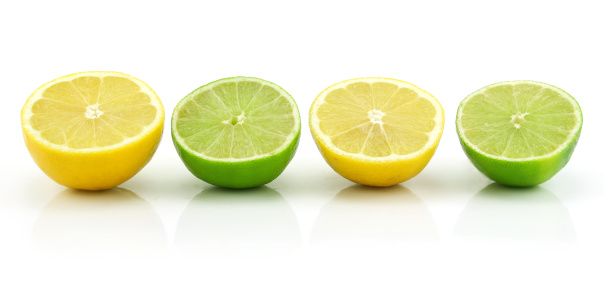Luscious Lemon and Lime
Love these flavours and want to learn more? Look no further.

Bottled Juice
You can find bottled Lemon and Lime juice in most grocery stores. While it usually does the job, there are many more options that you may find more flavourful. If you do choose to use it, check to be sure that the juice you’ve chosen does not have added sugars.
Fresh Lemons and Limes
That’s right – fresh! Often seen perched on the rim of a glass, these fruits have much more potential. You can slice and squeeze them to add a burst of flavour to any dish. Thai and other Asian food are accented well with lime, while lemon is often used in Mediterranean cuisine. Many recipes also use the zest of the fruit, which is made from finely grating the peel.
Grilled Lemon
Grilling a lemon warms it nicely for your dish and helps to release its juices. They also look great.
How to grill lemons:
- Heat a grill to medium-high heat or heat a frying pan over medium-high heat.
- Cut the lemons in half crosswise, pop out any visible seeds, and brush the cut sides with grape seed or olive oil. Sprinkle the cut sides with fine sea salt, if you like.
- Set the lemons cut side-down on the hot grill or in the frying pan. Cook, without moving, until the lemons are heated through and charred on the cut side - about 3 minutes.
Lemon and Lime Crystals
TRUE Lemon and TRUE Lime are crystalized products made from the oils and juices of the fruits. They come in boxes of 32 small packets, each packet equalling one large lemon wedge and containing 0 calories, 0 sugars and 0 fat per serving. They have a long shelf life and make it very easy to add a bit of quick flavour. They are also very portable and easy to have on hand when travelling or eating out.
Top 3 Places to use Lemon and Lime
- Water: Improve the taste of your water by adding any of the above listed options – a fresh slice in a glass or crystals works best.
- Dressings: You’ll see these flavours used in dressings in the following posts - Asparagus and Jicama Spring Salad, Mexican Slaw, Raw Turnip “Noodle” Salad. You can also try making a super simple dressing by whisking together the juice and zest from one lemon, the juice and zest from one lime, ¼ cup olive oil, ¼ tsp salt and ¼ tsp ground white pepper.
- Seasoning and Marinades: Pan Seared Pork Chops and Garlic Roast Chicken both use these flavours. Lemon and Lime are excellent for the acidic portion of a marinade, but do not use a recipe with a lot of citrus if it will be sitting for longer than a couple of hours.



